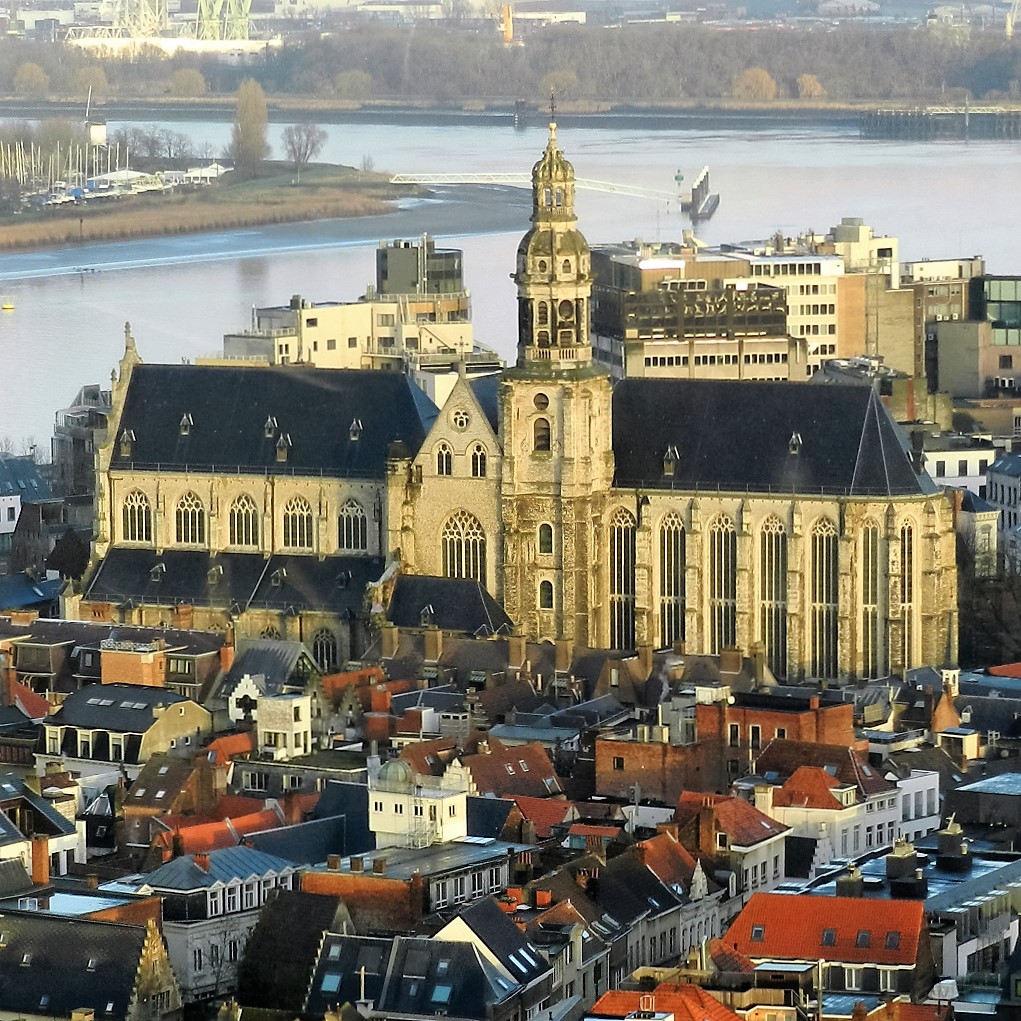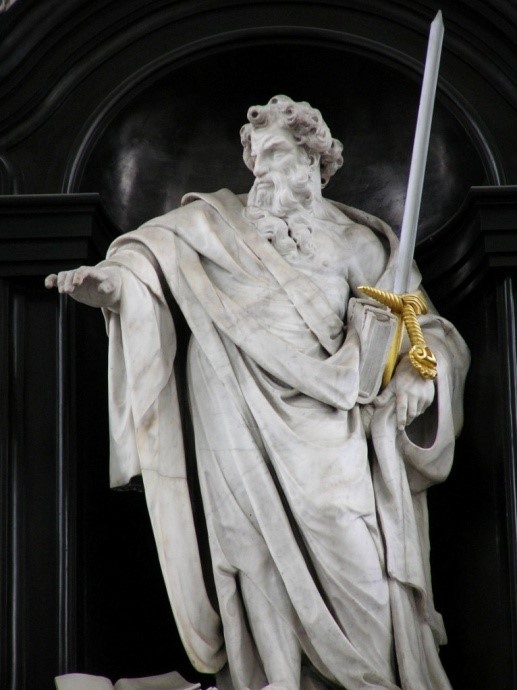Saint Paul’s, the Antwerp Dominican church, a revelation
The patron saint: Saint Paul
Paul's identity card
| born: | ca. 8 in Tarsus in Southern Asia Minor, as a Jew, from the tribe of Benjamin, but he also had Roman civil rights (Acts 16:32; 22:28). |
| education: | strictly Jewish (Acts 26:5), religious training into a convinced true Pharisee in Jerusalem (Gal. 1:14). He was familiar with philosophy and Greek literature (Acts 17:18) and poetry (Tit. 1:12). |
| First name: | Saul (Lat.: ‘Saulus’), which means ‘the one that has been begged from the Lord’. second, Roman name: ‘Paulus’ (‘the small one) |
| profession: | rabbi and scribe, also a tentmaker (Acts 18:3) |
| conversion: | initially he was a fanatic persecutor of Christians (Gal. 1:13), who agreed with Stephen’s cruel death. Shortly after this, ca. 37, he converted to Christianity on his way to Damascus: expressively told in a story about a vision of Christ that blinded him and made him fall to the ground (Acts 9:1). |
| ‘apostle’: | Although he never knew Jesus personally, he later (Gal. 1:17) became ‘apostle’, proclaimer of the faith, even though, due to his part in the persecutions of Christians, he did not feel worthy of this title (1 Cor. 15:8-9). In the year 44, at the so-called Apostolic Conference in Jerusalem he pleaded for preaching the gospelOne of the four books of the Bible that focus on Jesus’s actions and sayings, his death and resurrection. The four evangelists are Matthew, Mark, Luke, and John. ‘Gospel’ is the Old English translation of the Greek evangeleon, which literally means ‘Good News’. This term refers to the core message of these books. among the peoples, without the commitments of Jewish law, such as circumcision (Gal. 2:7). |
| missionary trips: | After his first three missionary trips he was imprisoned in Caesarea in 58 AD. But he appealed his case to the imperial tribunal. During his fourth voyage, via Crete, he was shipwrecked at Malta, and went to Rome via Syracuse. There he was put under house arrest for a while. |
| writings: | The fourteen epistles that are traditionally attributed to Paul, were meant to be read out loud to the young Christian communities of important ancient towns. This makes him, after the four evangelists, the most important writer of the New TestamentPart of the Bible with texts from after the birth of Jesus. This volume holds 4 gospels, the Acts of the Apostles, 14 letters of Paul, 7 apostolic letters and the Book of Revelation (or Apocalypse).. |
| death: | About 67 AD he was taken prisoner in Rome. According to tradition he died a martyrSomeone who refused to renounce his/her faith and was therefore killed. Many martyrs are also saints. on 29th June, the same day as Peter. As he was a Roman citizen he was beheaded (with a sword) in the times of Emperor Nero. |
| surname: | ‘Teacher of the peoples’ (doctor gentium), because the Apostolic Conference in Jerusalem decided that Peter would preach the Gospel among the Jews (‘the circumcised’) and Paul among the ‘non-Jews’ (‘the uncircumcised’) or the gentiles (Gal. 2:7-8). |
| Saint’s days: | 25th January (Paul’s conversion); 29th June (‘Peter and Paul’) |
In art Paul can be recognized
| AS | BY |
| a saintThis is a title that the Church bestows on a deceased person who has lived a particularly righteous and faithful life. In the Roman Catholic and Orthodox Church, saints may be venerated (not worshipped). Several saints are also martyrs.: | the aureole. In other words: a Saint, in whom God’s salvation can be experienced more, radiates God’s light of love and wisdom. |
| apostleThis is the name given to the principal twelve disciples of Jesus, who were sent by Him to preach the gospel. By extension, the term is also used for other preachers, such as the Apostle Paul and Father Damien (“The Apostle of the Lepers”).: | a book or scroll, open or closed. Since his conversion he took Christ, ‘The word of God’, for the guidance of his life, and like the other apostles, preached Jesus’ Gospel to everyone. barefooted: “Carry no money bag, no sack, no sandals” (Lc. 10:4); “How beautiful are the feet of those who bring (the) good news!” (Rom. 10:15), which is based on Isaiah (52:7). |
| Jewish scribe: | a voluminous book, which stands for the entire Bible. As a Jewish scribe he studied the so-called Old TestamentPart of the Bible with texts from before the birth of Jesus.. Since his conversion he considered this as the precursor of the New Testament. |
| author of Epistles: | a parchment folio or banderol. His Epistles that were included in the New Testament are evidently represented by Paul’s attribute as an apostle, the Bible. |
| preacherA priest, deacon or lay person who explains the Bible readings during the celebration of Mass. Sometimes a preacher also acts outside of Mass celebrations (and in the past he did so regularly) to clarify certain points of faith and to encourage the churchgoers to a more Christian way of life. and ‘teacher of the peoples’: | a rhetoric pose, i.e. one arm lifted up and open handed. |
| 2nd most important apostle: | in a series of apostles he mostly takes the second position, after Peter, in conformity with the first or ‘Roman’ canonSomeone who, together with other canons, is attached to a cathedral or collegiate church and whose main task is to ensure choral prayer. of the Holy MassThe liturgical celebration in which the Eucharist is central. It consists of two main parts: the Liturgy of the Word and the Liturgy of the Eucharist. The main parts of the Liturgy of the Word are the prayers for mercy, the Bible readings, and the homily. The Liturgy of the Eucharist begins with the offertory, whereby bread and wine are placed on the altar. This is followed by the Eucharistic Prayer, during which the praise of God is sung, and the consecration takes place. Fixed elements are also the praying of the Our Father and a wish for peace, and so one can symbolically sit down at the table with Jesus during Communion. Mass ends with a mission (the Latin missa, from which ‘Mass’ has been derived): the instruction to go out into the world in the same spirit.. Therefore the twelfth and official apostle Matthias has to stand aside. Also apart from this series Paul and Peter are considered ‘the princes of the apostles’. The fact that he is nearly as important as Peter is thanks to his contribution to evangelization as ‘teacher of the peoples’. |
| martyr: | the sword, the instrument of his death as a martyr by decapitation, and the palm as a sign of victory. The martyr, who in the world is a loser, obtains the final victory with God and at his Joyous Entry into Heavenly Jerusalem he is welcomed with waving palms. |
| own physiognomy: | often bald, usually with a long beard |
| patron of Rome: | in the company of Peter and with a Roman building in the background. After all both were buried in Rome after their deaths as martyrs. ‘To go to the apostle’s tombs’ means to go on a pilgrimage to Rome. |



